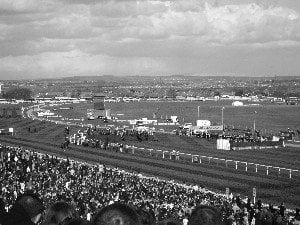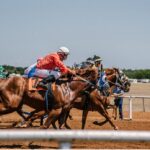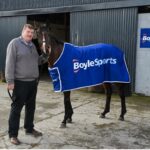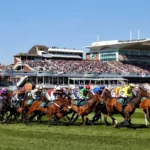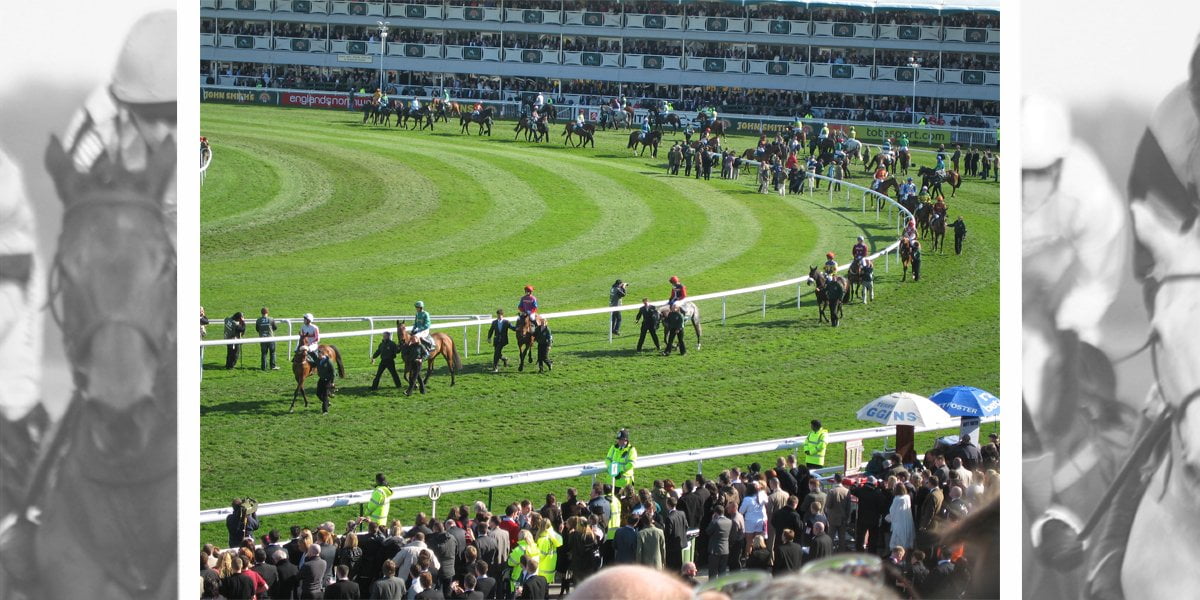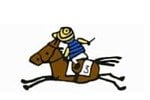The Grand National may seem a very macho race, and it’s certainly the most demanding of horse and rider in the entire calendar, but there is something about the drama and high emotion of Aintree which seems to draw the ladies.
Indeed, for many years the course was run by one such: the remarkable Mirabel Topham who started adult life as a chorus girl, but subsequently proved herself a shrewd businesswoman and ruled her husband and his interests with a firm hand, if not a rod of iron.
The first official races Aintree in 1929 – which were on the Flat – were organised by a syndicate led by hotel owner Mr William Lynn. Leasing land from Lord Sefton to meet the growing public interest in ‘steeplechasing’ – then in its infancy – and following negotiations with the local farmers, he set out a course and built a grandstand. The Aintree website records that the course staged its initial jump fixture in 1835, although in fact this was held in the neighbouring parish of Maghull. In February 1839 Lottery became the first winner of the Grand National on the Aintree course. In those days the horses had to jump a stone wall (now the water jump), cross a stretch of ploughed land and finish over two hurdles. The race was then known as the Grand Liverpool Steeplechase.
By the 1840s Lynn took more of a back seat due to ill health and a new syndicate was formed. With the support of the Earls of Sefton and Derby, member Mr Edward W Topham (who had been in Lynn’s original syndicate and was a respected handicapper) had moved from Middleham in 1837 to become Clerk of the Course. He gradually took charge of the Grand National, and this began the Topham family’s three-generational association with the race. From 1843 he made the Grand National a handicap – until then it had been a weight-for-age race – and changed the name of the race to ‘The Liverpool and National Steeplechase’ In 1847 he changed it again to ‘The Grand National’.
Edward W Topham took over the lease of Aintree in 1848 and became Clerk of the Course. The Topham family owned substantial tracts of land around Aintree, having built the racecourse stables on their own land in the 1840s, and in 1949 they bought the course outright from Lord Sefton. Edward died in 1987, his sons managing the business thereafter. A succession of family heirs followed until Edward AC Topham inherited in 1910. On his death in 1932 the reins passed to his brother Arthur who was by contrast a weak man and something of a drunk; luckily for Aintree however, he was blessed with a shrewd and determined wife.
Mrs Mirabel Topham was made Chairman of the course and it was she who steered the race into prominence whilst running the course with great aplomb and canny business sense over a 40-year period. A former Gaiety Girl and well-known actress before her marriage, she joined the board in 1934, and soon took charge after the Topham family bought the course in 1949. A forward thinker, Mrs Topham built a standard fence and hurdles track within the established Grand National course, which she named after Lord Mildmay, a renowned amateur jockey and great supporter of the Grand National. The Mildmay Course opened in 1953 and still stages Grade 1 racing. At this time too, races from Aintree began to be shown on cinema newsreels, adding to its popularity.
Following a visit to Goodwood, Mrs Topham also built a motor-racing circuit, which circles the Grand National track to this day. It hosted a European Grand Prix and five British Grand Prix, Stirling Moss winning his first Grand Prix there in the inaugural year 1955 (he was also victorious in both 1957 and 1959). The final motor race on the track was staged at Aintree in 1962.
Meanwhile Mrs Topham’s name became synonymous with the Grand National for an entire generation. Sir Peter O’Sullevan described her as “a real old battle-axe”, but the lady known as ‘the Queen Bee’ was a complex woman, who knew in spite of her personal problems what was important, and how to achieve that. Her husband, described by Mirabel’s biographer as a “genial Peter Pan” was a drunkard and something of a womaniser. He was content however to defer to her, and she ran matters with the help of her niece and nephew, all four living together at Paddock Lodge within the Aintree compound, with Mirabel ruthlessly hushing up scandals threatened by Edward’s louche behaviour. The household was renowned for its hospitality: one guest at a Jockey Club lunch there observed “Mrs Topham, I disagree with every word you’ve uttered, but I can’t beat the succulence of your roast beef”. Personal tragedy was mitigated by a passion for good food, and Mirabel’s weight ballooned accordingly.
Even so, as her biographer and close friend Joan Rimmer wrote: “There would have been no National without her because [Edward] could not have coped, even though he was the direct descendant who inherited it. She was the stronger of the two. When he was appointed to head Tophams Ltd, the racing community were in dismay because they thought he could not cope. It was she that pulled it through.”
Mirabel Topham in the 1970s pointed out that the Grand National has always been a challenge that stood out in the modern world. “What I would like to keep about Aintree is the uniqueness of the race,” she said; “It’s something different and in these days of standardisation I think it’s rather nice to be something different. All the jockeys who have been over Aintree are all very proud if they’ve even got round, never mind won the race, that’s something you can only hear the best talk about.”
She also took on the bookmakers, which was then an entirely male preserve. She decided in a pioneering move that there should be charges for information from the course: “I thought that everyone should pay for their raw material,” she explained in an interview years later: “The bookmakers were getting away with it and we were having a hard uphill fight and getting very little in return. I remember marching in to William Hill – I don’t know anything about bookmakers, I don’t back horses even, I haven’t got time, so I wanted to know more about them. So, I walked in to William Hill, they didn’t know me from Adam, but I was reasonable and I think it was from this that the Racecourse Amenities Fund was started and from there the racecourse drew something, a very small finance, but not all the bookmakers paid and that was when the trouble started and we really got going. So, we said if they didn’t pay we’d get a campaign and make them pay.”
The war however had hit courses hard, and Aintree suffered lean times in the following years. The novelty of televised races from 1960 also hit attendances. Having lost Arthur in 1958, Mrs Topham announced in 1965 that the course would be sold to a property developer, and Aintree was finally sold to Bill Davies in 1973. A further ten years of uncertainty was to follow, with each Grand National billed as ’the last’. Davies vowed to continue the race, but his heart never seemed to be in the sport, and the tripled entrance fee of 1975 led to the smallest ever attendance. Bookmakers Ladbrokes negotiated a lease and managed the course efficiently through the 1970s, but the threat had not gone away; and its stoutest defender Mrs Topham died in 1980. A complacent racing public became used to the course ‘crying wolf’, so when Davies finally announced his intention not to renew the Ladbroke lease but to close Aintree, there was uproar.
Aintree’s ability always to produce a ‘story’ in the form of Jenny Pitman’s 1983 victory as the first lady trainer of a Grand National winner was just what the cause needed, and fortunately at last everyone pulled together in aid of the ‘Save the Grand National Appeal’, raising the necessary sum to keep the course open. In 1983 the Racecourse was thus purchased by the Aintree Racecourse Charitable Appeal Trust, which executed a long lease to the Jockey Club.
The future of Aintree now seems secure, and its April meeting which showcases the Grand National now rivals Cheltenham for prestige and excitement, giving an opportunity to those many horses which dislike Cheltenham’s switch-back the chance to excel at top level on a flat track. The Grand National will always be the jewel in its crown however; its unique length, fences and annual drama will long ensure that.
By Sara Waterson
Allison is the Publisher of Eclipse Magazine. She loves going to the Races and is learning to bet (despite being officially the worst bettor in the History of the Universe), there’s a lot more to learn…


